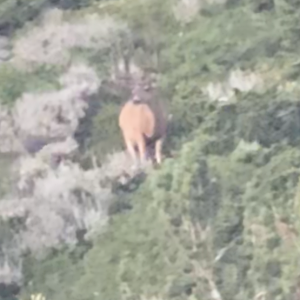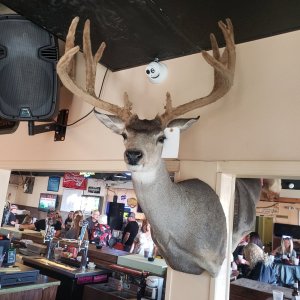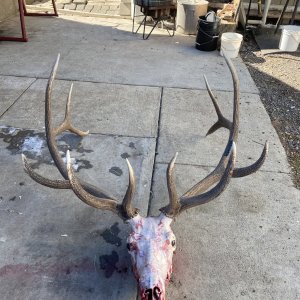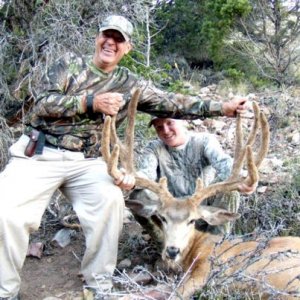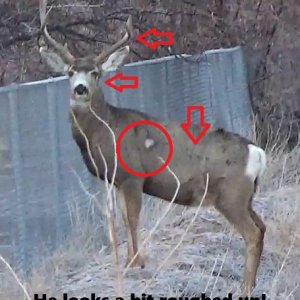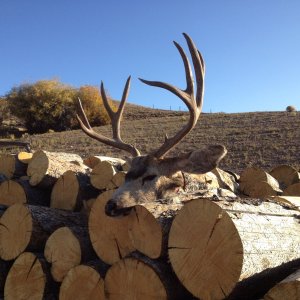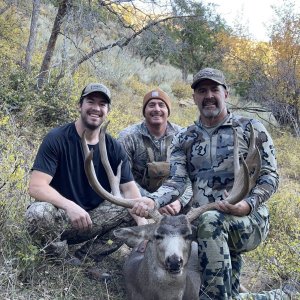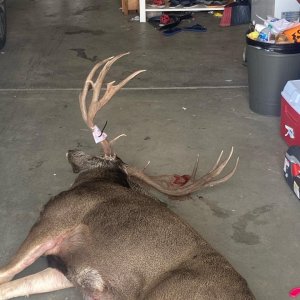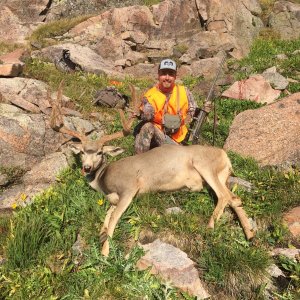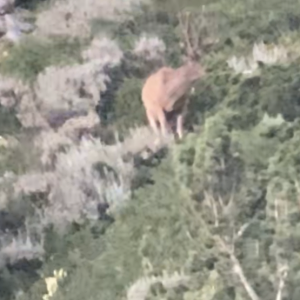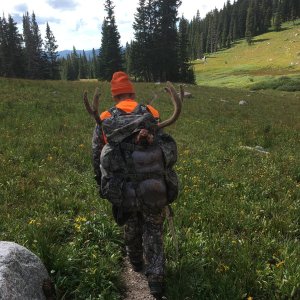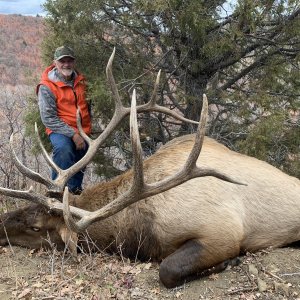P
Prince
Guest
I found this article in The Daily Herald after my wife received a phone call from a relative who knows this family (the Sorensens). The dead man in the story, according to my wife's relative, was an avid hunter, processed his own game, and usually handled the brains and spinal chords of his deer as he removed his deers' antlers and processed the meat. His wife firmly believes (she says so in the article) that he received his mysterious illness from handling deer parts.
I thought you all might want to read it, so here it is. I'll also include the link:
http://www.heraldextra.com/content/view/165116/
Eureka widow looks for answers in unusual death of husband
----------------------------------------------------------------
HEIDI TOTH - Daily Herald
A Eureka man died late last year from Creutzfeldt-Jakob Disease, sometimes known as the human form of mad cow disease, said his wife.
Max Sorensen died on Dec. 30 at age 62, just five weeks after doctors at the University of Utah diagnosed him with the degenerative brain disorder. He was autopsied and quickly buried in a sealed metal casket, without being embalmed because of the risk it would present.
The worst part of the devastating ordeal for his wife, Julie Sorensen, is the uncertainty. She's not sure when he got the disease or how he got it, and she's not getting much help from the doctors, because they don't know much more.
"I don't think they have any idea," she said. "They know so very little about it they really can't give us any definite answers."
CJD is most commonly known as the human form of mad cow disease, but most of the cases are unrelated to the bovine disease. The disease is rare; about one in a million people worldwide have it. Most have the sporadic type; they have no known risk factors but got it anyway. It's not contagious except through contact with an infected brain, spinal fluid or nervous tissue.
Sorensen's death was the first case in Utah in the past few years. The state average is about two deaths a year, said Dr. Susan Mottice, an epidemiologist for the Utah Department of Health. Some years there are several deaths, while other years there aren't any. CJD is a neurological disease caused by infectious prions that mutate from normally harmless protein in the body, even though it can remain dormant for up to 40 years, according to the National Institutes of Health.
Early symptoms of the disease include problems with muscle coordination, personality changes and impaired vision. As it gets worse an infected person can have involuntary muscle jerks, blindness, weakness in arms and legs and eventually a coma.
"You would see a rapid deterioration in things like motor skills, speech and the ability to care for oneself," Mottice said. "To some degree it might resemble Alzheimer's, except it's more severe and it would progress much more rapidly."
About 85 percent of CJD cases are sporadic; another 5 to 10 percent are genetic, according to the National Prion Center at Case Western Reserve University. The rest are acquired through the transplant of infected tissue, contact with infected tissue or with contaminated instruments or the ingestion of contaminated meats. Trying to protect people from this form of the disease is why United Blood Services and the American Red Cross stopped accepting blood donations from people who have spent a significant consecutive amount of time in countries with a higher incidence of degenerative brain diseases.
Sorensen is suspected to have had a sporadic form of the disease, although Julie Sorensen and her family think it might be related to his hunting habit. She believes handling animals' horns could have been what got her husband sick.
"We all feel that this has come from deer, we really do," she said.
Chronic wasting disease, another prion-caused degenerative disorder, has been found in Utah deer as recently as October, according to the Utah Division of Wildlife Resources. Doctors don't know enough to verify her guess; Mottice said there is no evidence linking chronic wasting disease to CJD, and scientists at the National Prion Center believe there's a possibility chronic wasting disease can be transmitted to humans.
Doctors do believe people who eat infected cows can become infected and will eventually develop variant or acquired CJD after an incubation of about 12 years, according to the center. Mottice said she doesn't know of any of these cases that were acquired in the United States; most were picked up in Europe. Infected beef products usually include or were in contact with the spinal column or nervous tissue also, not just muscle, she said.
There's no cure and no way to treat CJD yet because doctors aren't sure what they're dealing with. The disease hasn't been linked to a virus or a bacteria, and the prion has a number of unique characteristics that make it difficult, as the Sorensens found out.
"It's not a live organism, so there's no way they can kill it," Julie Sorensen said.
It also doesn't have any genetic material, according to the National Institutes of Health, and a long incubation period. The harmless and infectious prion are almost identical; both are made of amino acids but the infectious prion is folded in a different way. In some sporadic occurrences, harmless prions simultaneously change into the infectious form and then alter prions in other cells in a chain reaction.
But while she wants to know the answers, Julie Sorensen is trying to put her husband's disease behind her and focus on their 42 years of marriage.
"His kids and grandkids were just his whole life, and everything that he done, he done with them," she said.
Heidi Toth can be reached at 344-2543 or [email protected].
CJD belongs to a family of human and animal diseases known as transmissible spongiform encephalopathies.
Spongiform refers to the characteristic of an affected brain, which becomes filled with holes.
Human types
Kuru -- identified in people of an isolated tribe in Papua New Guinea and has almost entirely disappeared
Fatal Familial Insomnia and Gerstmann-Straussler-Scheinker disease -- very rare hereditary diseases found in a few families throughout the world
Animal types
Bovine spongiform encephalitis -- found in cattle; more commonly known as mad cow
Scrapie -- found in sheep and goats
Feline and mink encephalopathy
Source: National Institutes of Health
I thought you all might want to read it, so here it is. I'll also include the link:
http://www.heraldextra.com/content/view/165116/
Eureka widow looks for answers in unusual death of husband
----------------------------------------------------------------
HEIDI TOTH - Daily Herald
A Eureka man died late last year from Creutzfeldt-Jakob Disease, sometimes known as the human form of mad cow disease, said his wife.
Max Sorensen died on Dec. 30 at age 62, just five weeks after doctors at the University of Utah diagnosed him with the degenerative brain disorder. He was autopsied and quickly buried in a sealed metal casket, without being embalmed because of the risk it would present.
The worst part of the devastating ordeal for his wife, Julie Sorensen, is the uncertainty. She's not sure when he got the disease or how he got it, and she's not getting much help from the doctors, because they don't know much more.
"I don't think they have any idea," she said. "They know so very little about it they really can't give us any definite answers."
CJD is most commonly known as the human form of mad cow disease, but most of the cases are unrelated to the bovine disease. The disease is rare; about one in a million people worldwide have it. Most have the sporadic type; they have no known risk factors but got it anyway. It's not contagious except through contact with an infected brain, spinal fluid or nervous tissue.
Sorensen's death was the first case in Utah in the past few years. The state average is about two deaths a year, said Dr. Susan Mottice, an epidemiologist for the Utah Department of Health. Some years there are several deaths, while other years there aren't any. CJD is a neurological disease caused by infectious prions that mutate from normally harmless protein in the body, even though it can remain dormant for up to 40 years, according to the National Institutes of Health.
Early symptoms of the disease include problems with muscle coordination, personality changes and impaired vision. As it gets worse an infected person can have involuntary muscle jerks, blindness, weakness in arms and legs and eventually a coma.
"You would see a rapid deterioration in things like motor skills, speech and the ability to care for oneself," Mottice said. "To some degree it might resemble Alzheimer's, except it's more severe and it would progress much more rapidly."
About 85 percent of CJD cases are sporadic; another 5 to 10 percent are genetic, according to the National Prion Center at Case Western Reserve University. The rest are acquired through the transplant of infected tissue, contact with infected tissue or with contaminated instruments or the ingestion of contaminated meats. Trying to protect people from this form of the disease is why United Blood Services and the American Red Cross stopped accepting blood donations from people who have spent a significant consecutive amount of time in countries with a higher incidence of degenerative brain diseases.
Sorensen is suspected to have had a sporadic form of the disease, although Julie Sorensen and her family think it might be related to his hunting habit. She believes handling animals' horns could have been what got her husband sick.
"We all feel that this has come from deer, we really do," she said.
Chronic wasting disease, another prion-caused degenerative disorder, has been found in Utah deer as recently as October, according to the Utah Division of Wildlife Resources. Doctors don't know enough to verify her guess; Mottice said there is no evidence linking chronic wasting disease to CJD, and scientists at the National Prion Center believe there's a possibility chronic wasting disease can be transmitted to humans.
Doctors do believe people who eat infected cows can become infected and will eventually develop variant or acquired CJD after an incubation of about 12 years, according to the center. Mottice said she doesn't know of any of these cases that were acquired in the United States; most were picked up in Europe. Infected beef products usually include or were in contact with the spinal column or nervous tissue also, not just muscle, she said.
There's no cure and no way to treat CJD yet because doctors aren't sure what they're dealing with. The disease hasn't been linked to a virus or a bacteria, and the prion has a number of unique characteristics that make it difficult, as the Sorensens found out.
"It's not a live organism, so there's no way they can kill it," Julie Sorensen said.
It also doesn't have any genetic material, according to the National Institutes of Health, and a long incubation period. The harmless and infectious prion are almost identical; both are made of amino acids but the infectious prion is folded in a different way. In some sporadic occurrences, harmless prions simultaneously change into the infectious form and then alter prions in other cells in a chain reaction.
But while she wants to know the answers, Julie Sorensen is trying to put her husband's disease behind her and focus on their 42 years of marriage.
"His kids and grandkids were just his whole life, and everything that he done, he done with them," she said.
Heidi Toth can be reached at 344-2543 or [email protected].
CJD belongs to a family of human and animal diseases known as transmissible spongiform encephalopathies.
Spongiform refers to the characteristic of an affected brain, which becomes filled with holes.
Human types
Kuru -- identified in people of an isolated tribe in Papua New Guinea and has almost entirely disappeared
Fatal Familial Insomnia and Gerstmann-Straussler-Scheinker disease -- very rare hereditary diseases found in a few families throughout the world
Animal types
Bovine spongiform encephalitis -- found in cattle; more commonly known as mad cow
Scrapie -- found in sheep and goats
Feline and mink encephalopathy
Source: National Institutes of Health

